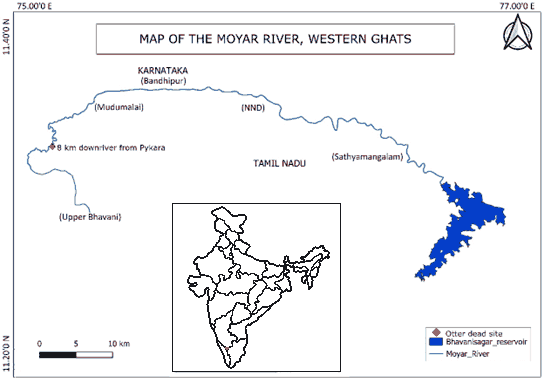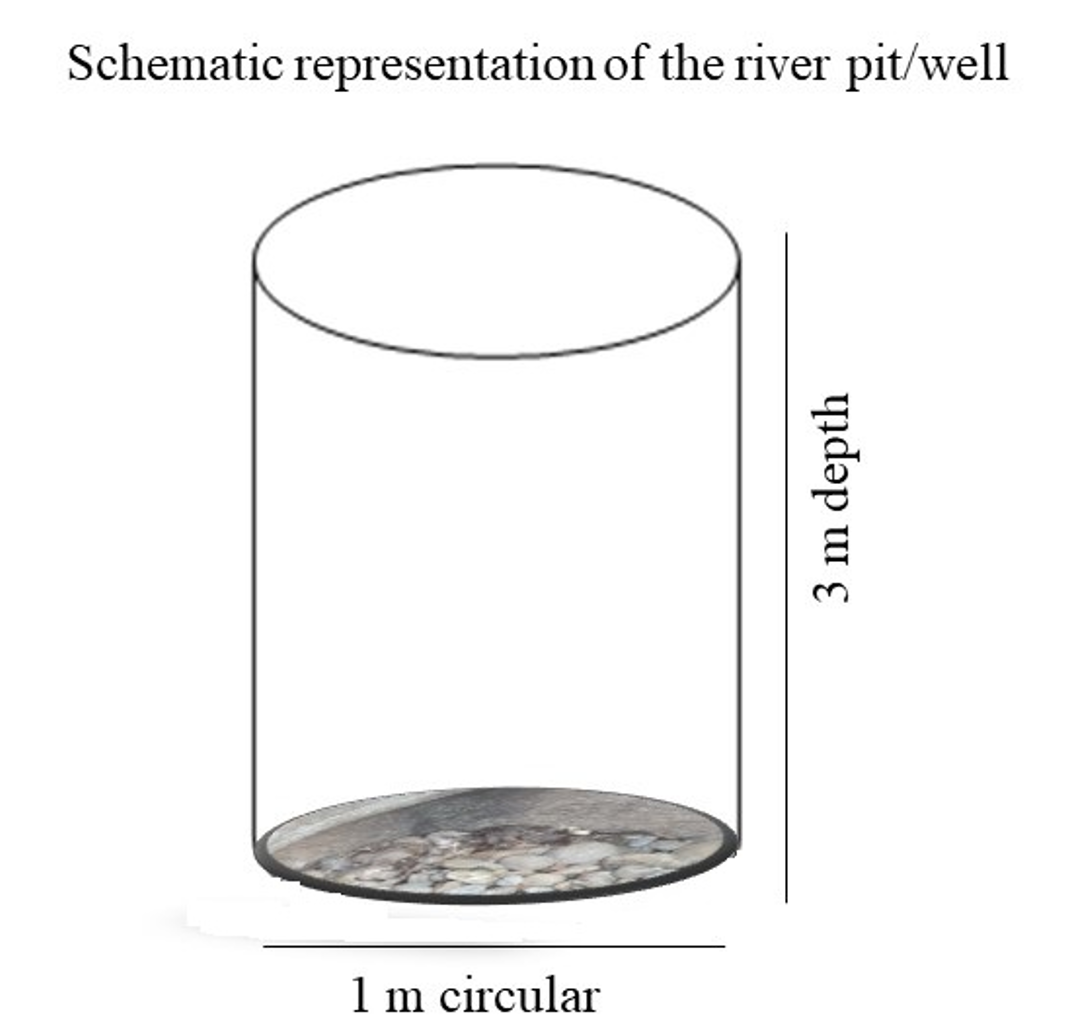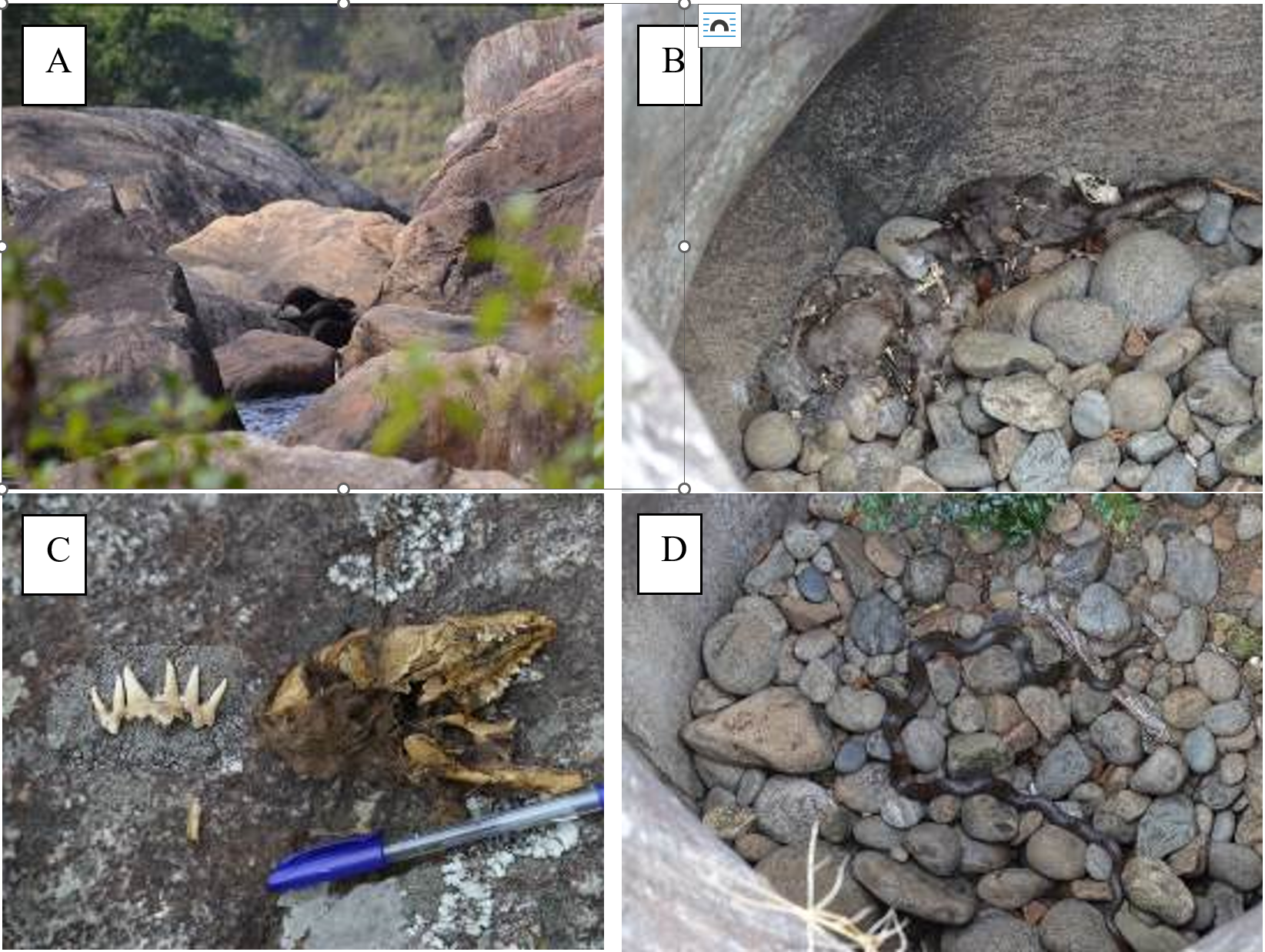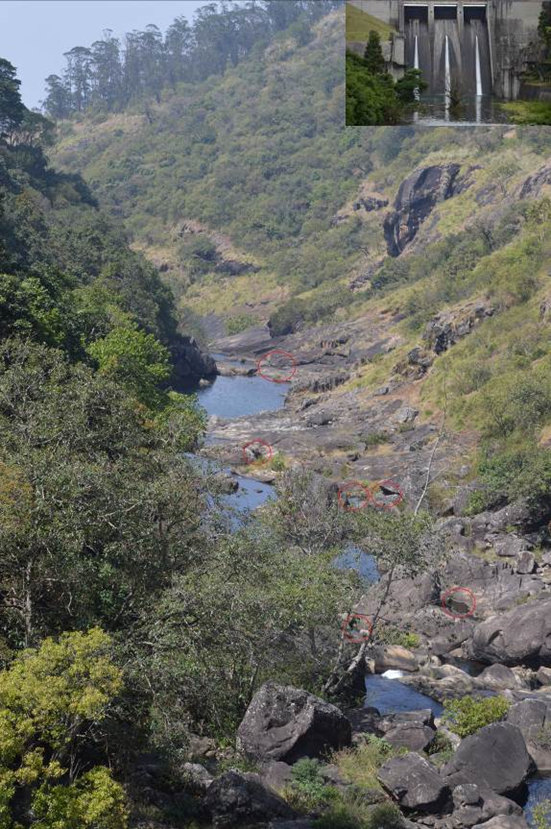IUCN/SSC Otter Specialist Group Bulletin

©IUCN/SCC Otter Specialist Group
Volume 41 Issue 1 (March 2024)
Citation: Narasimmarajan, K., Palei, H.S., and Mathai, M.T. (2024). Do Natural River Pits pose a Danger to Otters? A Field Report from the Moyar River, Western Ghats, India. IUCN Otter Spec. Group Bull., 41 (1): 24 - 30
Do Natural River Pits pose a Danger to Otters? A Field Report from the Moyar River, Western Ghats, India.
Kannadasan Narasimmarajan1*, Himanshu Shekhar Palei2, and Manu Thomas Mathai1
1Department of Zoology, Madras Christian College, Tambaram, Chennai – 600 059, India
2Aranya Foundation, Bhubaneswar, Odisha, India
*Corresponding Author Email: wildlife9protect@gmail.com
Received 24th July 2023, accepted 6th October 2023
Abstract: This paper reports an unusual and accidental mortality event of a group of Asian small-clawed otters (Aonyx cinereus nirnai Illiger, 1815) trapped inside natural river pits in the Moyar River, Western Ghats, India. Otter populations are likely declining in the Western Ghats region due to various anthropogenic pressures and human-cause mortalities (poaching, roadkill, retaliate killing). Safeguarding otters from accidental mortality will help support their future survival. We discuss preventive measures to avoid such a cause of accidental mortality.
Keywords:Asian small-clawed otter; Mortality; River Pits; Hydroelectric Dam; Western Ghats
INTRODUCTION
Asian small-clawed otters (Aonyx cinereus nirnai) act as apex predators in aquatic ecosystems, playing a crucial role in regulating the overall health and functioning of the ecosystem. The geographic distribution of the Asian Small-clawed otter extends in South Asia from India through Southeast Asia, and on the island of Palawan (Wright et al., 2021; Kruuk, 2006). Three of the four species of Asian otters can be found in the Western Ghats region, the Smooth-coated otter (Lutrogale perspicillata), the Asian small-clawed otter (Aonyx cinereus nirnai), and the Eurasian otter (Lutra lutra) (Perinchery et al., 2011). Asian small-clawed otter populations in the Western Ghats are likely declining (Perinchery et al., 2011), such that preventing mortality from natural and human causes is essential for their long-term survival. Two species of otters, the Smooth-coated and Asian small-clawed otter, have been reported in the Moyar River of the Western Ghats (Narasimmarajan and Mathai, 2019). The Asian small-clawed otter is restricted to hilly regions there (> 850 m asl) in primary and secondary forest streams, where they live in small groups of 3-5 individuals (Narasimmarajan, 2020). Asian small-clawed otters often search for food in river pits in river systems, where they hunt for crustaceans and fish (Narasimmarajan, 2020).
The Moyar River is 102 km long, originates in upper Bhavani River at 2054 m asl and flows through several protected areas, the Mudumalai Tiger Reserve (Mudumalai), Sathyamangalam Tiger Reserve (Sathyamangalam), Nilgiri North & South Divisions and the Bavanisagar Dam at 254 m asl (Narasimmarajan et al. 2021) (Figure 1). The upper reaches of the river area receive ~5,000 mm of rainfall, whereas the downriver area reaches receive ~824 mm of rainfall annually (Puyravaud and Davidar, 2013). Minimum and maximum annual average temperatures vary from 14˚C - 30˚C in higher elevations, and 25˚C -38˚C in the lower elevations (Narasimmarajanet al. 2019; Puyravaud and Davidar, 2013). The elevation of the river ranges from 2,054 m asl at Pykara Dam to 250 m asl at the Bavanisagar Dam (Narasimmarajan et al. 2021).

River pits are formed naturally when high water flows crack rock surfaces and creates a deep hole, or pit, in the bed of the river, about 1 to 3 meters deep (Fig. 2). These pits fill with water during a discharge from upstream hydroelectric dams, but dry up during the non-pumping time. Here we report a mortality event of Small-clawed otters in natural river pits, where they become trapped when, in search of food, they are unable to escape due to insufficient water level in a pit.

From 1947-54, the Tamil Nadu Electricity Board (TNEB) constructed a dam in Pykara on the Moyar River, with a hydro-electric power generation capacity of 28 MW/day. Unregulated water pumping during electricity generation controls the entire downstream river water flow, restricting the free movement of Small-clawed otters. Otters can become trapped in the deep river pits when the pumping of water is suddenly stopped. The otters cannot escape from the bottom of the pits when the water level falls too far below the surface level. Unregulated or sudden stoppage of water pumping from the dam can lead to death of a trapped otter due to starvation.
OBSERVATIONS
During an ecological survey of otters in the Moyar River on January 28, 2016, a group of otters was observed and photographed (Fig. 3A). Additionally, three Asian small-clawed otter carcasses were found in a river pit (Fig. 3B,C), along with a live Indian rat snake (Ptyas mucosa) (Fig. 3D). Many river pits were observed from Pykara to Thorappally River segments, but this was the only findings of otter mortality in a river pit. There may be other incidents of this kind which were unnoticed. Otters may have become trapped inside the pit when the hydroelectric dam authority stopped water discharge. Despite being skilled swimmers, Asian small-clawed otters, having small paws, might face challenges climbing slippery surfaces like deep rocky pits.

(A) A group of Asian small-clawed otters were photographed near the river pit where otter carcasses were seen; (B) three carcasses of Asian small-clawed otters in a natural river pit due to hunger; (C) skull and teeth of the Asian small-clawed otter collected from the natural pit; D) an Indian rat snake (Ptyas mucosa) found in the same river pit as the otters.
DISCUSSION
Although, natural-caused and human-caused mortalities of otters have been reported by many studies (e.g., Hussain, 1993; Weber Rosas and Ely de Mattos, 2003; Shivram et al. 2023). The accidental death of otters in their natural habitat due to unregulated water discharge by the hydroelectric dam is a novel observation. In the Moyar River, the population of Asian Small-clawed otters may be declining in the Western Ghats. Documenting natural and anthropogenic cause of death is critical for their long-term survival together with mitigating those causes. Natural river pits are a danger to small carnivores like otters when natural water flows from hydroelectric dams are stopped suddenly (Figure 4). During summer, insufficient water flow from the upstream Pykara Dam in the Moyar River can also cause a reduction in natural water flow towards downstream. The regulation of enough water flow released from dams in the region needs to be considered to prevent accidental deaths of otters and other wildlife often using the river pits in future.

View of the typical Asian small-clawed otter habitat in the Moyar River, Western Ghats. Red circle indicating the narrow river width with multiple river pits and stagnant water during an event of stoppage of water pumping from the Pykara Dam (insert).
REFERENCES
Hussain, S.A. (1993). Aspects of the ecology of smooth-coated otters Lutra perspicillata in National Chambal Sanctuary. PhD Thesis. Centre for Wildlife and Ornithology. Aligarh Muslim University. Aligarh, India.
Kruuk, H. (2006). Otters: ecology, behaviour, and conservation. Oxford University Press, New York. Online ISBN: 9780191728228 Print ISBN: 9780198565871
https://doi.org/10.1093/acprof:oso/9780198565871.001.0001
Narasimmarajan, K., Hayward, M.W., Mathai, M.T. (2021). Assessing the occurrence and resource use pattern of smooth-coated otters Lutrogale perspicillata Geoffroy (Carnivore, Mustelidae) in the Moyar River of the Western Ghats biodiversity hotspot. IUCN Otter Spec. Group Bull. 38(1): 43-58. https://www.iucnosgbull.org/Volume38/Narasimmarajan_et_al_2021.html
Narasimmarajan, K. (2020). Ecology of otters (Carnivore, Mustelidae) in river Moyar, Western Ghats, Southern India. PhD thesis Submitted. The University of Madras. 235 pp.
Narasimmarajan, K., Mathai M.T. (2019). Vulnerable otters; Ecology and conservation of Asian small-clawed otters (Anoyx cinereus) in river Moyar, Western Ghats, India. 14th International Otter Congress. IUCN Otter Specialist Group. April 8–13, 2019, Tangjiahe, China.
Perinchery, A. Jathanna, D., Kumar, A. (2011). Factors determining occupancy and habitat use by Asian small-clawed otters in the Western Ghats, India. Journal of Mammalogy. 92(4): 796 -802. https://doi.org/10.1644/10-MAMM-A-323.1
Puyravaud, J.P., Davidar, P. (2013). The Nilgiris Biosphere Reserve: an unrealized vision for conservation. Tropical Conservation Science, 6(4): 468-476. https://doi.org/10.1177/194008291300600401
Shivram, A., Sivasothi, N., Hsu, C.D., Hodges, K.E. (2023). Population distribution and causes of mortality of smooth-coated otters, Lutrogale perspicillata, in Singapore. Journal of Mammalogy 104(3): 496-508. https://doi.org/10.1093/jmammal/gyad007
Weber Rosas, C.F and Ely de Mattos, G. (2003). Natural deaths of Giant otters Pteronura brasiliensis in Balbina hydroelectric lake, Amazonas, Brazil. IUCN Otter Spec. Group Bull. 20 (2): 7 – 9. https://www.iucnosgbull.org/Volume20/Weber_Rosas_de_Mattos_2003.html
Wright, L., de Silva, P.K., Chan, B., Reza Lubis, I. & Basak, S. (2021). Aonyx cinereus. The IUCN Red List of Threatened Species 2021: e.T44166A164580923. https://dx.doi.org/10.2305/IUCN.UK.2021-3.RLTS.T44166A164580923.en
Résumé: Les Fosses Naturelles des Rivières constituent-elles un Danger pour les Loutres Cendrées ? Un Rapport de Terrain sur la Rivière Moyar, aux Ghats Occidentaux, en Indee
Cet article rapporte un cas de mortalité inhabituel et accidentel de loutres cendrées (Aonyx cinereus), piégées dans des fosses naturelles de la rivière Moyar, dans les Ghats occidentaux, en Inde. Les populations de loutres sont probablement en déclin dans la région des Ghats occidentaux en raison de diverses pressions anthropiques et de mortalités d'origine humaine (accident de la route, massacres en représailles). Protéger les loutres de la mortalité accidentelle contribuera à leur survie future. Nous discutons des mesures préventives pour éviter cette cause de mortalité accidentelle.
Revenez au dessus
Resumen: ¿Las Fosas Naturales en Ríos son Peligrosas para las Nutrias? Un Informe de Campo desde el Río Moyar, Ghats Occidentales, India
Este trabajo informa de un evento inusual y accidental de mortalidad de nutrias de uñas pequeñas Asiáticas, que quedaron atrapadas dentro de fosas naturales en el Río Moyar, Ghats Occidentales, India. Las poblaciones de nutria están posiblemente declinando en la región de los Ghats Occidentales, debido a distintas presiones antropogénicas y mortalidades de origen humano (atropellamimentos, muerte por represalia). Proteger a las nutrias de las mortalidades accidentales ayudará a su supervivencia futura. Discutimos las medidas preventivas para evitar ésta causa de mortalidad accidental.
Vuelva a la tapa
தமிழ்ச் சுருக்கம்: இயற்கை ஆற்றுப் பள்ளங்கள் நீர்நாய்களுக்கு ஆபத்தை ஏற்படுத்துமா? இந்தியாவின் மேற்குத் தொடர்ச்சி மலையில் உள்ள மோயார் நதியிலிருந்து ஒரு கள அறிக்கை.
இந்தியாவின் மேற்குத் தொடர்ச்சி மலையில் உள்ள மோயார் ஆற்றில் உள்ள இயற்கை ஆற்றுப் பள்ளங்களுக்குள் சிக்கி, ஆசிய சிறிய நகம் கொண்ட நீர்நாய்களின் அசாதாரணமான மற்றும் தற்செயலான இறப்பு நிகழ்வை இந்தத் தாள் தெரிவிக்கிறது. பல்வேறு மானுடவியல் அழுத்தங்கள் மற்றும் மனித காரணங்களால் ஏற்படும் இறப்புகள் (வேட்டையாடுதல், சாலைக்கொலை, பழிவாங்கும் கொலை) காரணமாக மேற்குத் தொடர்ச்சி மலைப் பகுதியில் நீர்நாய்களின் எண்ணிக்கை குறைய வாய்ப்புள்ளது. தற்செயலான இறப்பிலிருந்து நீர்நாய்களைப் பாதுகாப்பது அவற்றின் எதிர்கால உயிர்வாழ்வை ஆதரிக்க உதவும். தற்செயலான இறப்புக்கான இந்த காரணத்தைத் தவிர்ப்பதற்கான தடுப்பு நடவடிக்கைகளை நாங்கள் இந்தத் தாளில் விவாதிக்கிறோம்.
ஆரம்பத்திற்குத் திரும்பு


